Are you searching for some best egg-laying chicken breeds for your backyard farm? If that is the case, this guide will help you find the few best chickens for eggs with their pictures and names.
Selecting an excellent egg-laying chicken is most important if you need many fresh eggs all year long. So, let’s start the list of chickens that will lay plenty of eggs with their pictures and name.
Every poultry farmer wants to rear chickens that will lay as many eggs as possible daily. For every farmer to achieve this, they must choose the right chicken breed.
However, this doesn’t happen automatically or miraculously: farmers must ensure they provide the hen with a conducive environment and all the required essentials.
Your chicken must feed well, have a safe and comfortable nesting space, and be provided with the right temperature to lay eggs appropriately. People highly seek eggs because they are the cheapest source of protein. Hence, rearing an egg-laying chicken can be a lucrative project.
When you provide everything your hen needs, she will lay eggs daily. Chickens have several benefits apart from the production of eggs.
The egg-laying chicken will also provide you with meat and manure, which you will use for organic farming at no extra cost.
Chicken is a common meat worldwide and tops the list of the most-eaten meat in America. If you want to raise egg-laying chickens, you must focus on choosing the best breed.
Also read: Black Chicken Eggs: Real or Fake ‘Let’s Find Out’?
List of 19 Best Egg-Laying Chicken Breeds (With Pictures and Name)
There are many best egg-laying chicken breeds, so you should stick around to know which one to select from the list. Below, we have provided 19 best chickens that lay lots of eggs:
1. Leghorn Chicken
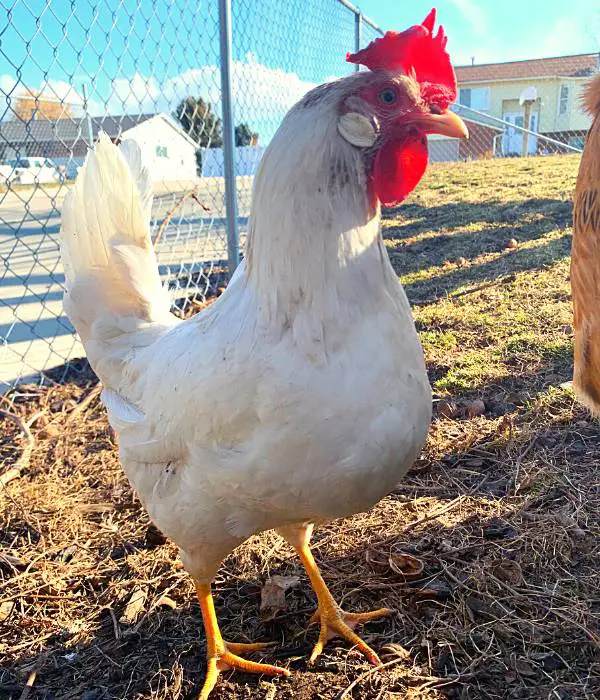
Leghorn originated in Italy and was first exported to North America in 1828. They lay eggs at around 4–5 months old and can lay up to 280–320 eggs yearly.
Their eggs are white and weigh 55–65 grams. There are 12 color varieties of these chickens, although the white leghorn is the most common.
Leghorns are one of the most popular egg-laying chicken breeds used worldwide.
They are shy and unfriendly and don’t like when some one touch them. They are active and hardy birds with a lively temperament.
These chickens are not typically broody, so their focus will be on producing eggs rather than raising chicks.
The average weight for a leghorn rooster is 7-8 lbs, while the hen weighs 5-6 lbs. As they constantly lay eggs, they have a lifespan of 5–6 years of age.
2. Australorp Chicken
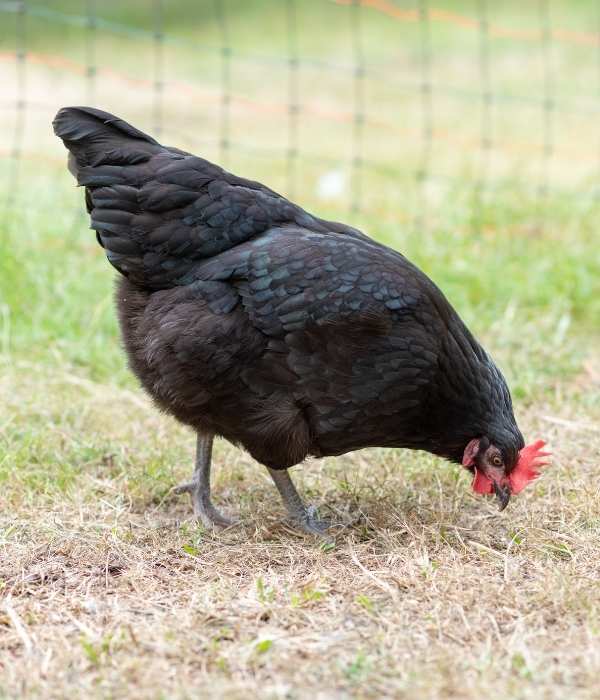
Native to Australia, the Australorp chicken is another excellent egg layer. They lay eggs at about 5–6 months old.
These dual-purpose chickens come in three colors – white, black, and blue – and earn recognition for their suitability for both egg production and meat purposes. The Australorp rooster is 8.5-10 lbs, and the hen is 6.5-7.9 lbs.
They are docile and friendly, hence safe to live with children. They lay 250-300 jumbo-sized eggs annually that are brown/tinted. Likewise, they are fast growers and begin laying eggs at 5 months.
Australorp is the most-bred chicken in America because of its broodiness, calm nature, friendly temperament, and beautiful appearance. They are good foragers and hence love feeding freely in an open place. Lifespan is about 6–10 years.
3. Austrawhite Chicken

Austrawhite is another best egg-laying chicken breed, resulting from a crossbreed between black Australorp and White Leghorns. It originated in Oregon, United States.
They lay eggs at around 5 months old and can lay up to 250–300 white eggs annually. Their eggs are large and weigh 50–59 grams. People keep them for their eggs and meat. They have the same lifespan as Australorp, i.e., about 6–10 years.
An Austrawhite rooster weighs 6.5-7 lbs, and it’s pure white, while a hen is 5 lbs and white with some black dots. Austrawhites are docile and friendly, and they are omnivorous.
These chickens don’t sit on eggs. However, even though they like roaming freely, they are prone to predators because of their bright colors and big bodies.
4. Barred Plymouth Rock Chicken

The Barred Plymouth Rock chicken originated in the United States and is a popular egg-laying breed.
They lay eggs at around 5–6 months old and can produce up to 200–280 eggs annually. Their eggs are medium and brown colored.
They occasionally become broody and display a friendly, docile temperament.
It’s one of the chickens that beginners can breed since it doesn’t need much attention. A male Plymouth Rock weighs 7.5 lb, and a female 6.5 lb.
They are calm and friendly birds. The average lifespan of this chicken breed is about 6–10 years. That’s why it’s one of the most popular egg-laying chicken breeds.
5. Golden Comet Chicken
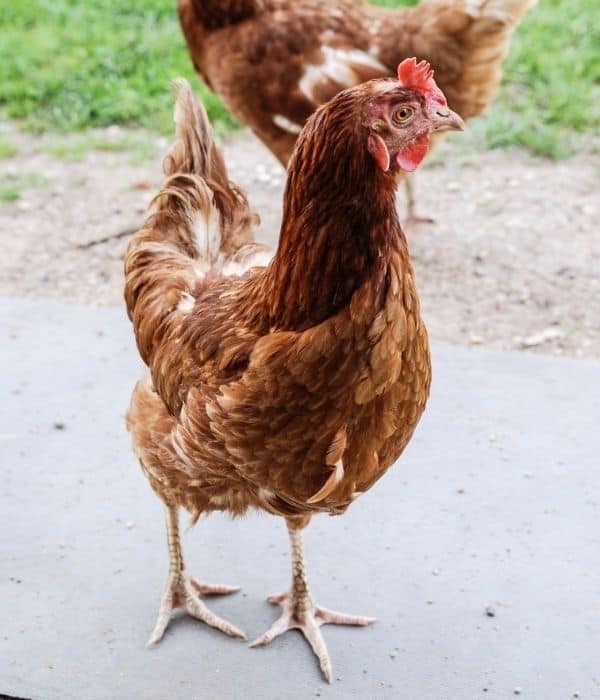
The Golden Comet chicken is a hybrid breed developed in the United States for high egg production. They lay eggs at 4–5 months old and can produce up to 250–300 eggs annually.
Golden Comets produce large, brown eggs with an average weight of 55–60 grams. These chickens are not typically broody and have a friendly, calm nature.
They have reddish-brown feathers with some white flecks. Likewise, they are light or medium chickens, with a grown male weighing about 6 lbs and a hen 4 lbs.
Golden Comets are a hybrid chicken from Rhode Island Red and White Leghorn chicken. They love to be free raging in the yard.
They have a short lifespan like Leghorns, i.e., around 4–5 years. The Golden Comets are one of the best egg-laying chicken breeds.
6. Rhode Island Red Chicken
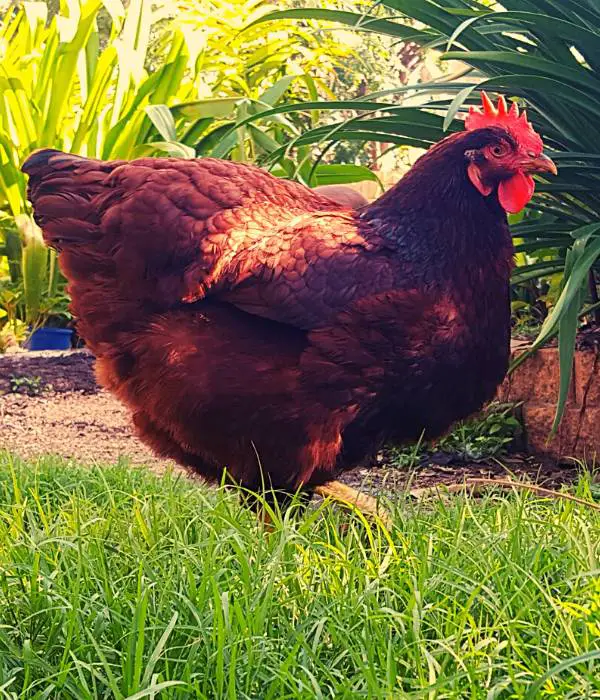
Rhode Island Reds are an American breed known for their excellent egg production and meat purposes. They start laying eggs at around 5–6 months old and can produce up to 200–300 eggs per year.
Their eggs are large and brown, weighing around 55–60 grams. Rhode Island Reds have a moderate tendency to become broody and hardy temperament. RIRs are one of the best egg-laying chicken breeds which tolerate many weather.
These chickens are good to rear since they have fewer expenses, highly resist diseases, and are free rangers. People raise this chicken worldwide for its excellent egg-laying capabilities and for its meat.
They are large chickens; the hen is 6.5 lbs, while the rooster is 8 lbs. Their large size makes them suitable for meat, and their meat is delicious.
The hens of this breed lay perfectly for three years. Rhode Island Reds have a lifespan of about 5–8 years.
7. Speckled Sussex Chicken
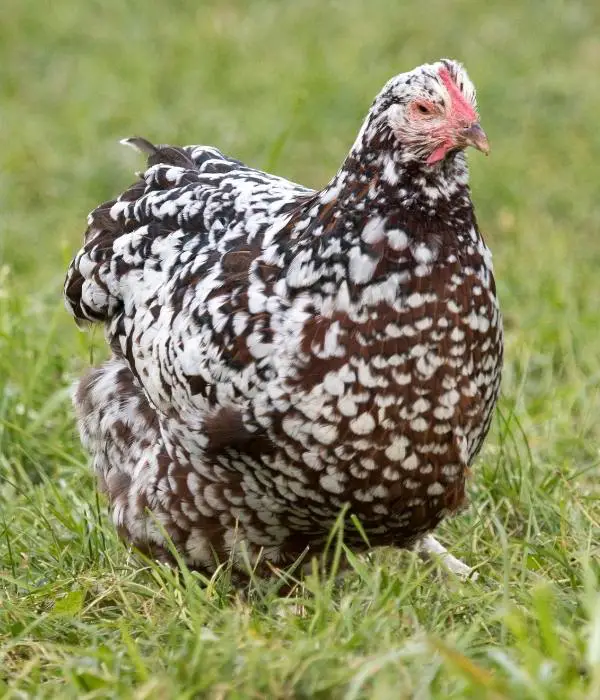
Originating in England, the Sussex chicken is a versatile breed that is a good egg layer and meat producer. The meat of this chicken breed is super tasty.
They have eight colors, although most are white with black necks and tails. The Speckled Sussex hens lay eggs at around 5–6 months old and can produce up to 200–250 eggs annually.
Sussex chickens produce large, brown eggs weighing around 55–60 grams. They have a calm temperament and can be good pets.
They actively forage, exhibit some broodiness, and have a calm, friendly temperament.
The hen produces 250-280 large brown-colored eggs yearly. A fully grown rooster weighs 8 lbs, and a hen 6–7 pounds. They have a lifespan of 6–10 years.
8. Isa Brown Chicken

The hybrid was developed in France and is one of the best egg layers. They begin laying eggs at an early age of 4–5 months old and can produce up to 300–350 eggs annually.
Isa Browns produce large, brown eggs with an average weight of 60–65 grams. These hens of this breed are not known to be broody and have a friendly and docile temperament.
The hens are brown, but the males are white. They are medium size chickens; the rooster weighs 6 lbs, while the hen weighs 5 lbs.
The downside of these chickens is their vulnerability to prolapse and kidney-related diseases. They almost resemble Golden Comet, Rhode Island Red, and Red Star chickens.
These are not the kinds of chickens that are noisy when they lay eggs. They are not suitable for meat but are edible. The downside of this chicken breed is its life expectancy. It has a lifespan of about 3–4 years.
9. Lohmann Brown Chicken
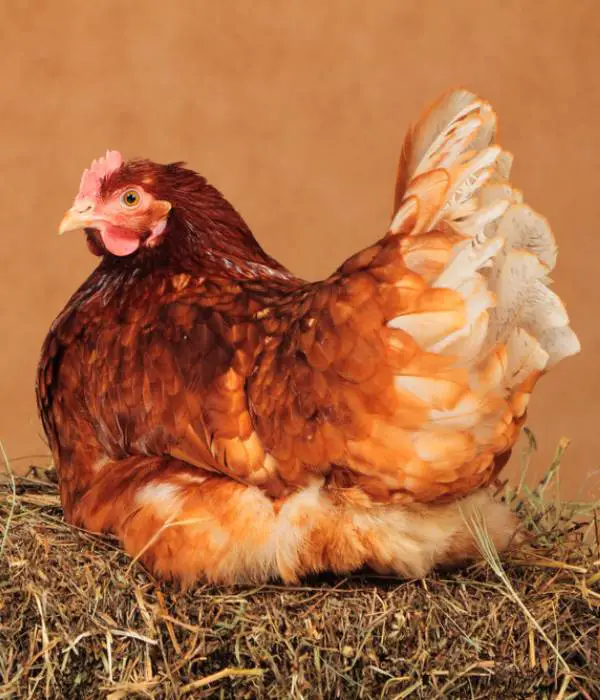
Lohmann Brown chickens are a hybrid breed developed in Germany for high egg production. They are friendly chickens and one of the best egg-laying chickens.
They begin laying eggs at 4–5 months old and can produce up to 300–320 eggs annually. Lohmann Browns produce large, brown eggs with an average weight of 60–65 grams.
They get along well with other pets and domestic animals, and baby chicks show a friendly nature.
Lohmann Browns are low-feeders and consume 110 grams in a day. They are small birds weighing 4.5 lbs for a hen and 8 lbs for roosters. These hens are not broody and have a friendly, docile temperament.
They are one of the best egg-laying chicken breeds; moreover, they have an excellent life expectancy. The average lifespan of this chicken is around 9–10 years.
10. Black Star Chicken
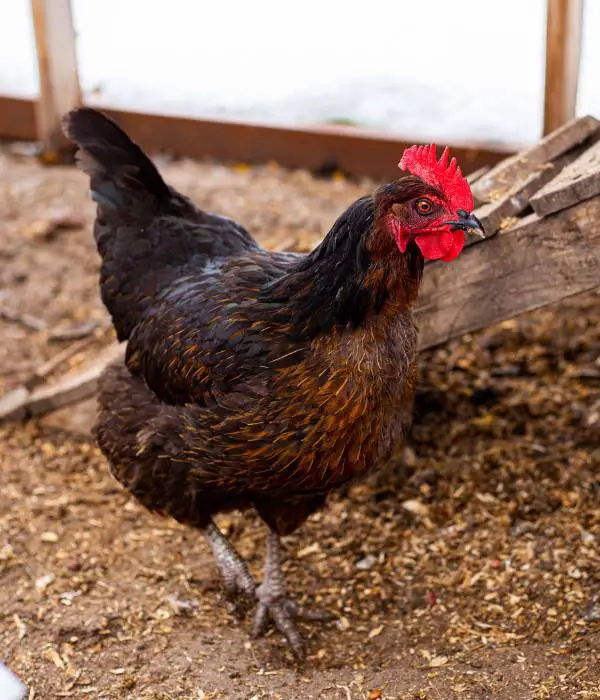
Black Star chickens are a hybrid breed developed in the United States for high egg production. It results from mixing a Rhode Island rooster and a Barred Plymouth Rock hen.
They lay eggs at 4–5 months old and can produce up to 250–300 eggs annually. Black Stars produce large, brown eggs with an average weight of 55–60 grams.
This is the chicken you will see in most homesteaders and backyards because of its extraordinary qualities.
They are good foragers that go about looking for their preferred food. It lays several eggs, which is why people produced it during World War II to increase food since there was a shortage.
These hens are neither broody nor aggressive; instead, they are friendly and gentle. Males weigh 8 lbs, while females weigh 6 lbs. Additionally, they have an average lifespan of about 5–8 years.
11. Ameraucana Chicken
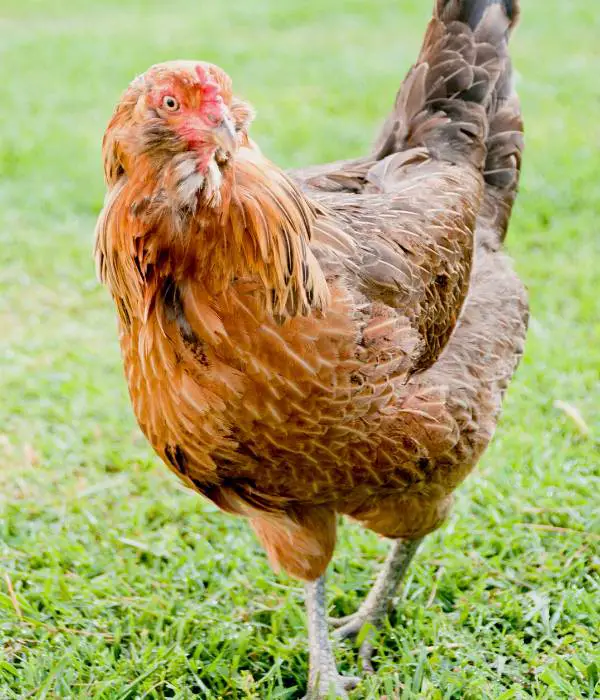
Originating in the United States, the Ameraucana chicken is a unique egg layer known for producing blue or green eggs.
These chickens are a crossbreed of numerous hens and wild animals. People consider them the chickens that produce the healthiest eggs.
Their eggs are bluish-green, which is why people call them Easter eggs. The Ameraucana chicken is similar to Araucanas; the difference is the beards and muffs in Ameraucanas.
They start laying eggs at around 5–6 months old and can produce up to 200–250 eggs annually. Ameraucana eggs weigh around 50–55 grams.
The hen weighs 5.5 lbs, while the rooster is 6.5 lbs; their eggs have low cholesterol levels and are expensive. These chickens have a moderate tendency to become broody and are known for their friendly and docile temperament.
They forage for food and make good backyard chickens. Furthermore, the average life expectancy of Ameraucanas is around 7–10 years.
12. Delaware Chicken
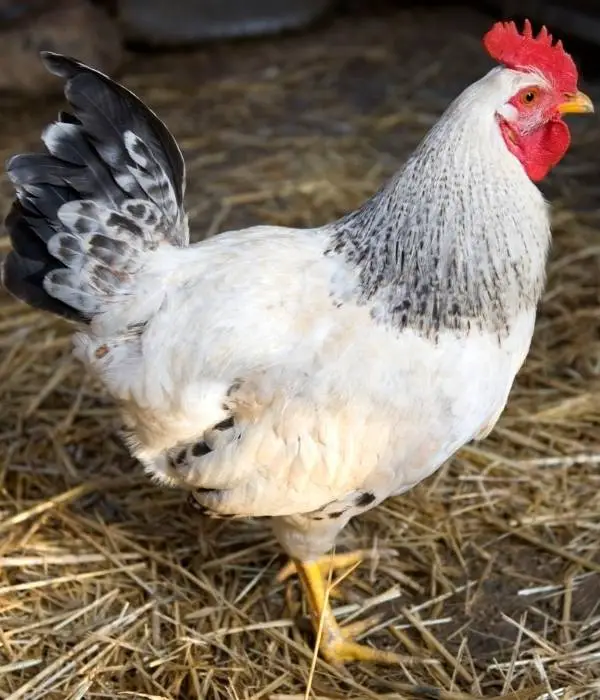
Native to the United States, the Delaware chicken is a dependable egg layer. They are also called India River Chicken, a crossbreed of Barred Plymouth Rock and New Hampshire Red hen.
They start laying eggs at around 5–6 months old and can produce up to 200–250 eggs annually. Their eggs are large and brown, weighing around 55–60 grams.
Delawares occasionally become broody and exhibit a friendly, curious, and gentle temperament. The hen weighs 6 lbs, while the rooster is 8 lbs.
They range freely, and they can also stay comfortably in a small space. Moreover, Delaware chickens live around 5–6 years on average.
13. Marans Chicken

Originating in France, the Marans chicken is known for producing dark brown eggs. They begin laying eggs at around 6–7 months old and can produce up to 150–200 eggs per year.
Maran eggs are large and weigh around 60–65 grams. They need a small space to roam and feed, so small backyard farmers prefer them.
However, they can be difficult to tame, so you shouldn’t leave them with children or keep them as pets. The roosters weigh 7 lbs, and the hens 6.5 lbs. They are docile and friendly chickens.
These chickens often show a moderate tendency to go broody, and they are well-known for their friendly and gentle nature, making them excellent companions in a farmyard setting.
The hens of this breed stop laying eggs after 3 years; additionally, Marans chickens have a life expectancy of about 5–8 years.
14. Wyandotte Chicken
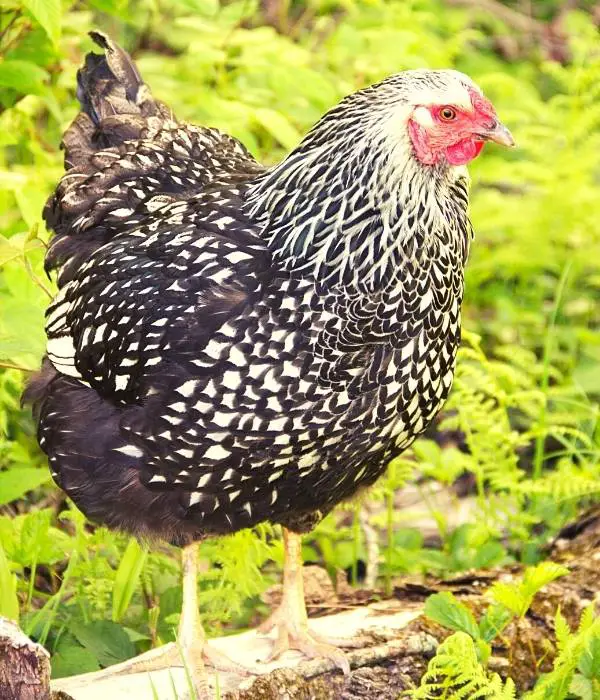
Native to the United States, the Wyandotte chicken is a popular egg-laying chicken breed. Wyandottes have different colors, but silver and gold are the most common.
They begin laying eggs at around 5–6 months old and can produce up to 200–240 eggs per year. Wyandotte eggs are large and brown, weighing around 55–60 grams.
These chickens have a moderate tendency to become broody and are known for their friendly and docile temperament.
The hen weighs 6 pounds, while the rooster weighs 9 pounds, and they serve multiple purposes by providing both meat and eggs. Furthermore, the Wyandotte chicken has a lifespan of 6–10 years.
15. Ancona Chicken
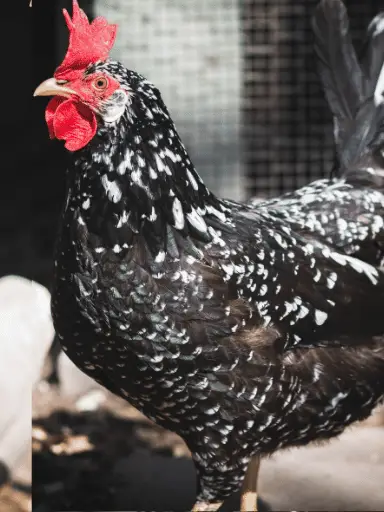
Originating from Italy, the Ancona chicken is a dependable egg layer. It’s a jumpy and nervous chicken that can’t concentrate on one place.
They start laying eggs at around 5–6 months old and can produce up to 220–280 eggs per year. Ancona eggs are medium-sized and white, weighing around 50–55 grams.
The hens rarely go broody and are known for their lively and strong nature, making them great foragers that can adapt well to different living conditions. Ancona male chicken weighs 12-13 lbs, while females weigh 8.8-9.9 lbs.
Their bodies are yellow and covered with a blend of black and white feathers. Additionally, the average lifespan of Ancona chickens is about 5–7 years.
16. Barnevelder Chicken
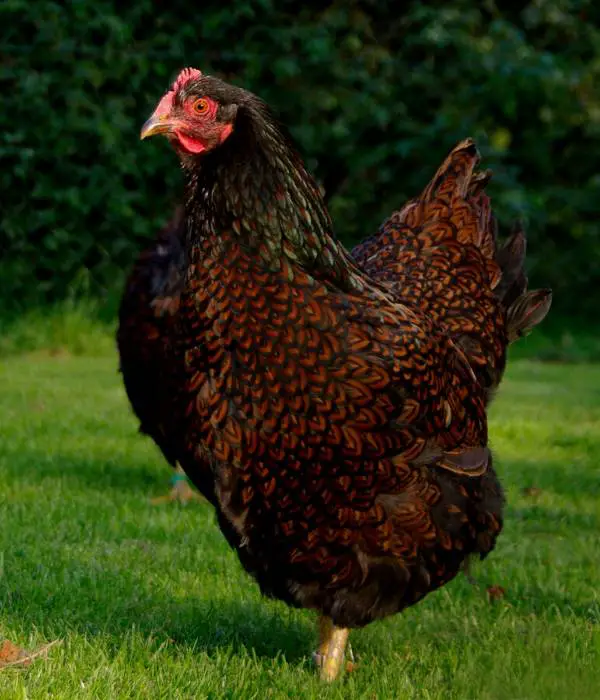
It’s a crossbreed between the Dutch Landrace and the Asian jungle fowl that originated in Holland. The Barnevelder chicken is famous for laying beautiful dark brown eggs.
They begin laying eggs at around 6–7 months old and can produce up to 150–200 eggs per year. Barnevelder eggs are large and weigh around 60–65 grams.
These Barnevelder hens have a moderate tendency to become broody and are known for their friendly and calm temperament.
The male chicken is 6.6-7.7 lbs, while the female is 5.5-6.2 lbs. They are docile, friendly, and curious birds but are broody occasionally.
They are beautiful chickens with different colors, double-laced silver and double-laced blue, a mixture of black and brown, white, silver blue, and chamois.
Likewise, they are easy to maintain, and it is reared for both meat and eggs. The average lifespan of Barnevelder chickens is about 6–10 years.
17. Hamburg Chicken
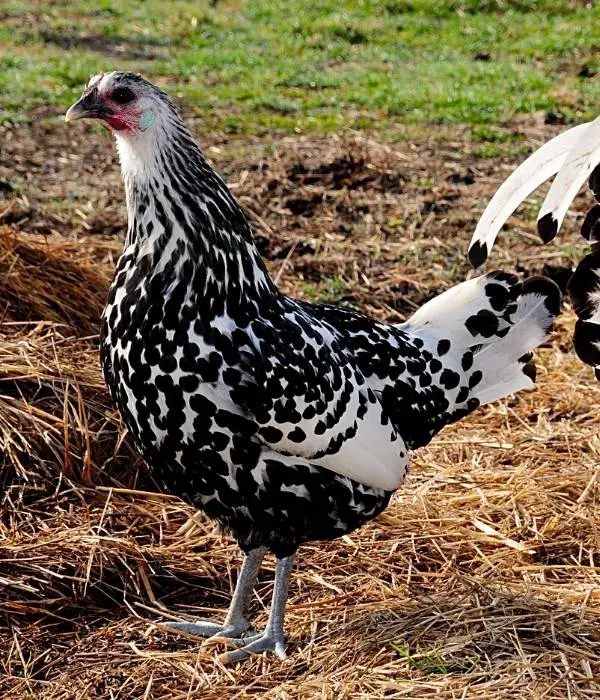
Originating in Germany, the Hamburg chicken is one of the best egg-laying chicken breeds.
They start laying eggs at around 5–6 months old and can produce up to 200–250 eggs annually. Hamburg eggs are medium-sized and white, weighing around 50–55 grams.
They are attractive birds with white feathers and black dots. The hens of the breed have a low tendency to become broody and are known for their active and hardy temperament.
However, the roosters are aggressive, especially in an enclosed space. A Hamburg male weighs 4.4-5.5 lbs, and the hen is 3.5 -4 lbs.
The life expectancy of Hamburgs is about 6–8 years; however, they may live longer if raised with special care and good feed.
18. Easter Egger Chicken

Easter Egger chickens are a hybrid breed known for producing a variety of egg colors, including blue, green, and pink.
They are a breed of Araucanas, intended to produce a better breed that is more resistant to diseases.
They begin laying eggs at around 5–6 months old and can produce up to 200–250 eggs per year. Easter Egger eggs are large and weigh around 55–60 grams.
The EE hens moderately become broody and people know them for their friendly and docile temperament.
The Easter Egger hens lays about 200 medium to large eggs annually. The EEs hens lay distinct color of eggs like blue, green, white, pink, tan, or dark brown eggs.
Easter Egger roosters weigh 5 lbs, while hens weigh 4 lbs; moreover, these chickens are docile, friendly, and hardy. They can live up to 5–8 years.
19. New Hampshire Red Chicken

New Hampshire Red is a crossbreed of several breeds like Andalusia, Minorca, Sumatra, and Sebright bantam. Originating in the United States, the New Hampshire Red chicken is a dual-purpose breed known for both egg and meat production.
They start laying eggs at around 5–6 months old and can produce up to 200–250 eggs per year. Their eggs are large and brown, weighing around 55–60 grams.
New Hampshire Reds have broad, meaty bodies, making them great for meat. Their maintenance costs are low, hence are great for small-scale farmers and starters.
They also gain maturity quickly and develop feathers rapidly. New Hampshire Reds have a low tendency to become broody and are known for their active and friendly temperament.
They lay large brown-colored eggs. A hen weighs 6.5 lbs, and a rooster is 8.5 lbs. They are docile but aggressive. The New Hampshire Red have a life expectancy of about 6–7 years.
Also read: Best Cold Hardy Chicken Breeds
Factors that Affects Eggs Quality and Numbers
There are different facts that affect egg production in Backyard chickens. According to the University of Florida, there are so many Non-infectious and Infectious diseases that cause a decrease in egg production.
The laying cycle of chickens is about 12 months, which starts when a hen reaches about 16-18 weeks of age. After 1 year of age, egg production gradually decreases to about 65%.
Now, let’s discuss the Factors one by one which affect backyard chicken egg production –
1. Chickens Age
Yes, As we have told you above, after 12 months of laying almost hens of every breed lay only 65% of eggs compared to the first 12 months of eggs.
Some hens stop laying eggs after 3–4 years of egg laying. It varies from chicken breed to breed.
2. Lack of Nutrition
We know chickens eat almost everything. You can read a list here: What can chicken eat? But the most important thing is whether they are getting proper nutrition from daily feed or not.
If you are raising free-range chickens in your backyard, then they eat various types of nutritious things like bugs, insects, grass, and some types of leaves. These are direct sources of vitamins, minerals, and carbohydrates.
But if you are raising chickens inside a shed or a closed coop, then they are limited to various external vitamin sources. So poor vitamin intake may cause a lack of egg production.
In that situation, you may need some good vitamin supplements for your flocks.
- Added egg nutrition - Formulated to produce a large egg...
- Added marigold extract - For brightly colored yolks
- 16% protein, 3.50% calcium - Maintains hen health and...
- Essential amino acids - Enhanced with lysine and...
- Prebiotics and probiotics - Supports immune and...
Last update on 2025-06-30 / Affiliate links / Images from Amazon Product Advertising API
3. Poor Quality Feed
Bad quality feed really hurts your chicken’s egg production quantity and quality. If you are growing your chicken inside a shed, always remember to use a good chicken feed.
Always use the first week Pre-starter, then until 21–25 days of age, give Starter and after that Finisher.
No products found.
4. Toxicosis
There are several types of salts and elements which are needed for better growth of chicken, but at balanced levels. Increased salt levels reduce egg production.
Lack of Phosphorus absorption may lead to decreased egg production because it is fully related to calcium.
Increased Vitamin D3 Levels cause hypercalcemia. This may cause reduced egg production in chickens.
5. Anticoccidials
Some medicines like anticoccidials were added to different types of chicken feed. These are not given to commercial laying hens. E.g., the nicarbazin drug reduces egg production in chickens, which is an anticoccidials drug.
6. Mistakes in Poultry Management
Always check your chicken waterer and feeder. Fill them before they get empty. If hens live without food and water for a few hours, it directly affects negatively to the production of eggs.
If you are keeping your chickens inside the coop, then proper lighting is required. Hens need about 14 hours of day length for laying a good quantity of eggs.
7. Mites, Lice, and Fleas
Mites, Lice, and Fleas cause various types of health problems in chickens. They make chickens weak by sucking blood from the skin. It causes a lack of vitamins and minerals in the body, which indirectly reduces egg production in chickens.
- HEALING AID & SKIN REPAIR: Use a few times daily to...
- CHICKEN FIRST AID ESSENTIAL: Vetericyn Plus is a go-to...
- ANTIBIOTIC FREE & NON-TOXIC: The ingredients found in...
- VETERINARIAN RECOMMENDED: Made with safe and effective...
- TRUSTED BRAND: Vetericyn is a leader in at-home animal...
Last update on 2025-06-30 / Affiliate links / Images from Amazon Product Advertising API
8. Worm infestation in Chicken
Like humans, chickens also suffer from worm infestation. Endoparasites like Roundworm, Tapeworm live inside chicken intestines and suck all nutrients. This gradually decreases the appetite of chickens and causes diarrhea or even death.
In this type of condition, you can use poultry wormer. You can read more about Chicken Wormers Here.
- Ivermectin Pour On. Animal Health Supplies
- Manufacturer: DURVET INC D
- Manufacturer part number: 01-11042FP
Last update on 2025-06-30 / Affiliate links / Images from Amazon Product Advertising API
9. Diseases in Chickens
Chicken gets infected with various types of diseases like Newcastle disease, Infectious Bronchitis, Avian influenza, E Coli, etc. In these types of conditions, hens stop laying eggs because of a lack of nutrients in the body.
To keep your flocks safe from these types of infections, vaccination must be done properly.
Also read: Washing Eggs: Why and How to Clean Eggs?
FAQs on Egg Laying Chicken Breeds
What to Feed Egg Laying Chickens?
Egg laying chickens require a balanced diet to maintain their health and maximize egg production. Their diet should consist of a high-quality layer feed supplemented with calcium and fresh water.
You can also provide them with fresh fruits, vegetables, and occasional treats like mealworms or cracked corn.
How Many Eggs Do Chickens Lay?
The number of eggs that chickens lay varies depending on the breed, age, and other factors. On average, chickens can lay between 200–320 eggs per year. However, some breeds like Leghorns and hybrid breeds like Isa Browns can lay up to 300–350 eggs per year.
What’s the Best Egg Laying Chicken?
The best egg laying chicken depends on your specific needs and preferences. If you want a breed that produces a large number of eggs, Leghorns, Isa Browns, and hybrid breeds like Golden Comets are worth considering.
If you want a breed that produces unique egg colors, consider Ameraucanas or Easter Eggers. For a dual-purpose breed, New Hampshire Reds, or Sussex chickens are worth considering.
Are Silkies Good Egg Layers?
Silkies are not known for their egg-laying abilities. While they lay eggs, they are not as productive as other breeds and typically lay around 100–120 eggs per year. Silkies are popular for their unique appearance and friendly temperament.
How Often Do Easter Eggers Lay Eggs?
Easter Eggers can lay eggs anywhere from 2 to 7 times per week, depending on the individual bird and other factors. They typically lay around 200–250 eggs per year.
How Much Do Egg Laying Chickens Cost?
The cost of egg laying chickens varies depending on the breed, age, and other factors.
Final Words
In this post, you will find a list of the best egg-laying chicken breeds for your backyard farm with their names and pictures.
Furthermore, we have explained what are the major factors that mainly cause egg production.
I hope you liked this informative post and helped you to choose the best egg laying chicken breed for your backyard coop.
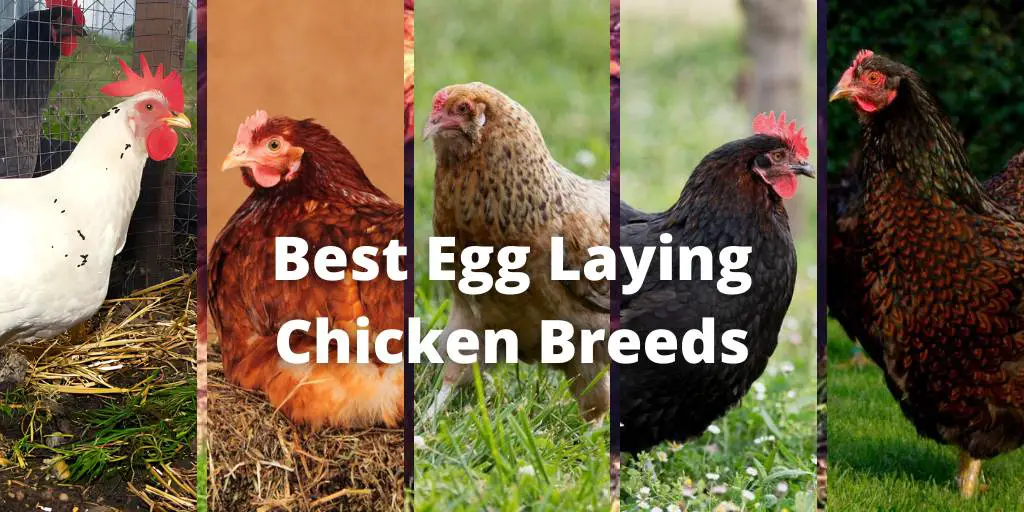





I dont have enough money to buy Good quality feed for my Lahmann Brown Classic chicken.
I am looking at a small flock of 7 hens for backyard egg production. I was told they were “barndrop” chickens. They look like Barnevelder or Plymouth Rock breed. About 9 months old. They look good for my purpose, I realize I will see a drop in egg production.
Thanks for writing here,
I have never heard of that breed, But if they look like Barnevelder or Plymouth Rock they may be mix breed.
My guess is it’s another way of saying “barnyard mix” or whatever the barn dropped. So basically, it’s the offspring of whatever mixed flock they have running around.
Yes, right, that’s a great name, barnmix.
Mr. Kumar. Exhaustive list you’ve put up. However, how many of these are available in India and from where does one get them.
Leghorn, Plymouth Rock, Rhode Island Reds are mostly available in India because these breeds can survive in the high-temperature states and countries.
What are the chances of attracting snakes while raising chickens for egg production?
The major cause of attracting snakes is the deep smell of the litter. It is good to clean them periodically.
Also, you must keep the door of the chicken coop closed in the daytime as there is a chance, snake get inside and rest for eating your flocks at night.